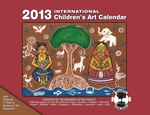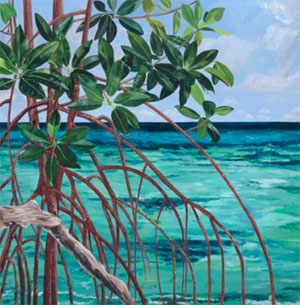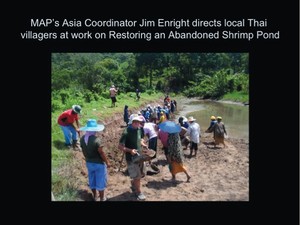Action Alerts: Join us in protecting Ecuador's forests – See sample letter and addresses to voice your concern – VIEW LETTER CALLING FOR MANGROVE ART SUBMISSIONS! We invite all primary school children from tropical and sub-tropical nations, and whose schools community. Selected winners will be published in a 2014 calendar to be distributed internationally to raise
Awareness in mangrove areas. Help us launch this program in your school by contacting science and art teachers in your area. e-mail: monicagquarto@olympus.net or mangroveap@olympus.net
We share this video from the group “Ecologists In Action” (In Spanish) – Enjoy – VIEW VIDEO Want to Make A Change? – Immediate Internship Opportunity CLICK HERE
Phulbari Coal Mine Blog – View Blog
Help save the Balikpapan Bay are: home of one of the largest populations of proboscis monkeys and one of the first orangutan release sites – Sungai Wain Protection Forest! Sign the petition MAP's 2013 Children's Mangrove Art Calendars are now available! 
Calendar offer $12 plus $2 shipping in US and $12 plus $4 shipping for intl. purchases. ORDER HERE
MAP's 2014 Children's Mangrove Art Calendar sponsors needed. View PDF Support MAP Through Art Support MAP through Art!

Enma Saiz has released only 50 signed reproductions. Read More Donate to MAP via Paypal
Giving could never be easier Green Planet Fundraising Assists MAP – LEARN MORE
URGENT – VOLUNTEERS NEEDED! MAP is looking for volunteer interns for its Thailand Headquarters – READ MORE MAP’s VOLUNTEER INTERNS HELP MAP MAKE A BIG DIFFERENCE
READ MORE
MANGROVE ISSUES MANGROVE BOOK – J. Primavera
The book Beach Forests and Mangrove Associates in the Philippines by J.H. Pimavera and R.B. Sadaba (ISBN 978-971-9931-01-0; National Library CIP QK938.C6 581.75109599 2012 P220120602) is now available. aves, flowers, fruits, utilization and silviculture.
SEE POSTER and order instructions View MAP’s uploaded Videos at MAPmangrover’sChannel “Education In The Mangroves" can now be seen on the PhotoPhilanthropy website here! Marvellous Mangroves – A Curriculum-Based Teachers Guide.
By Martin A. Keeley, Education Director, Mangrove Action Project
Read this 10 page history of the development of MAP’s educational curriculum VIEW DOCUMENT FOR MORE ON MAPs AWARD WINNING CHINA MANGROVE CURRICULUM VISIT THESE SIGHTS
SLIDE SHOW VIMEO SHOW Education In The Mangroves
Six minute video features discussion of Mangrove Action Project’s Mangrove Curriculum VIEW THE VIDEO
Article in Canada's Green Teacher Magazine – Read More
"Question Your Shrimp" Campaign Learn more about the affects of the shrimp industry on mangroves by visiting our blog Editor’s Note: Mangrove Action Project’s Executive Director, Alfrodo Quarto was interviewed about shrimp by Green Acre Radio’s Martha Baskin LISTEN TO INTERVIEW
Join MAP on Facebook
Sign the Consumer's Pledge to avoid imported shrimp

Not yet a MAP News subscriber?
Click here to subscribe.
Note to Our Readers:
We strive to keep active links in our newsletter. However, due to circumstances beyond our control, occassionally links to stories may become broken. If you find a link to a story is not functioning, please cut and paste the headline into your browser search bar. In most cases you should be able to locate the original story.
 Help Mangrove Action Project through your recycled E-Waste. List of Accepted E-waste Items: Injet Cartidges, Cell Phones, Pagers, GPS, Radar Detectors, Mobile Hot Spots, Calculators, eBook Readers, iPods/MP3 players, Digital/Video Cameras/Camcorders, PDAs, iPads/Tablets/Laptops, Video Game Consoles, Handheld Video Games Visit the Mangrove Action Project recycle website Click on the recycle button then click on the Download Shipping Label, and follow the instructions.  | FEATURED STORY  Dear Reader
It's that time of year again! We are doing our end-of-year request to our members to support our work. We have just learned that a generous MAP supporter is willing to donate up to $10,000 as a matching gift fund to match your donations. Please help us reach our goal of raising that $10,000 in matching funds now! Thus far, we have raised $2,000, so we are now one fifth of the way there! But time is running out, as we have omly until December 31st to raise the matching funds! Please do take this challenge and donate to MAP today. Help MAP stay effective in these changing times. Charitable deductions on the chopping block William Bigelow at Breitbart News notes that “the White House is pushing hard for reducing, or even eliminating, the tax deduction that is given when one makes a charitable donation,”. READ MORE Donate to MAP via Paypal: Giving could never be easier AFRICA AFRICA Mali’s Lush Wetlands Drained by Foreign Agribusiness

MALI – Mayor Daouda Sanankoua had traveled overnight by boat to see me, through flooded forests and submerged banks of hippo grass. There was no other way. Sanankoua's domain, the district of Deboye in the heart of Mali in West Africa, is on the edge of the Sahara. Yet Sanankoua's homeland is mostly water. His people live by catching fish, grazing cattle, and harvesting crops in one of the world's largest and most fecund wetlands, a massive inland delta created by the meandering waters of one of Africa's mightiest waterways, the Niger River. Nearly two million Malians live on the delta. "Everything here depends on the water," said the mayor. "But"—and here he paused gravely, pushed his glasses down an elegant nose, and began waving a long finger—"the government is taking our water. They are giving it to foreign farmers. They don't even ask us." What is happening here in Mali is happening all over the world. People who depend on the natural flow of water, and the burst of nature that comes with it, are losing out as powerful people upstream divert the water. READ MORE
ASIA
Indonesia's forests under renewed threat – experts

INDONESIA – Indonesia’s dwindling forests and an ambitious plan by the country’s president to reduce greenhouse gas emissions in the world’s third largest emitter are under threat due to the struggle between national and local governments for authority over precious forest land, environmental activists told AlertNet. In February, Indonesia’s Constitution Court struck down a controversial clause of the Forestry Law, saying it was unconstitutional for the central government to designate forest zones without proper mapping, after six plaintiffs, including five district heads (known as “bupatis”) from Central Kalimantan, a province in the Indonesian portion of Borneo, asked for a review of the law. This has left everyone wondering what would happen to millions of hectares of land that have been designated as forest zone but have not been mapped. Currently, only 14.2 million of some 130 million hectares are adequately mapped. READ MORE
No growth for Thai shrimp exports in 2013
THAILAND – Thailand's shrimp exports will probably post no growth next year due to sluggish global demand, especially in Europe and the US. Somsak Paneetatyasai, president of the Thai Shrimp Association, said export volume is expected to remain at 350,000 metric tons (MT) next year. Overall shrimp production is projected at 540,000 MT this year, down 10 percent from 600,000 MT in 2011, due to diseases known as early mortality syndrome and white spot syndrome. Exports have also declined by 10 percent this year. However, Somsak said export value would remain unchanged at 100 billion baht this year. He said price trends in 2013 would be about the same as this year _ THB 140 for shrimp sizes of 70 units per kilogram. Global shrimp production is expected to total 2.02 million MT this year, down 13 percent from last year, because of the spread of emerging shrimp diseases and climate changes. READ MORE
Thailand's small-scale fishermen turn marine advocates, using small boats and special nets to preserve ecosystem
THAILAND – The woefully depleted marine ecosystem of Thailand's Pattaya Bay has gained an unlikely ally, as a group of Naklua fishermen are repairing the damage done by overfishing by using smaller boats and special nets. The Naklua Small Fishing Boats group is comprised of about 25 local captains who are hoping to save the waters inside Pattaya’s Near Islands by moderating catches and building artificial reefs to replenish fish and coral. Sunya Phatsaena, a consultant to the group, said the fishermen have been sticking to waters a kilometer or less off shore for two years, using biodegradable nets with larger holes to catch only what they need. At the same time, they’ve been working with the Department of Marine and Coastal Resources to weave and deploy structures made of rope that can be transformed by hardened coral into artificial reefs. Fisherman Sombun Jankua said the new nets are made of bone byproducts and last only a year, compared with as many as six years for synthetic nets. But when nets are lost, they don’t suffocate coral reefs or entangle fish for long periods of time, as do the artificial versions. The problem, he said is that “most fishermen opt to use nets that offer the most convenience and return on investment.” READ MORE
Two arrests as Bangladeshis protests GCM mine plans in Phulbari

BANGLADESH – Three people were killed and over 200 injured on 26 August 2006 when paramilitary troops fired on a massive protest of some 80,000 demonstrators in Phulbari. The protesters were opposing a proposed open pit coal mine in the north-west of Bangladesh that the Bangladesh subsidiary of GCM Resources plc, Asia Energy, intends to implement. The project threatens to destroy the homes, lands, and water sources of as many as 220,000 people, and forcibly evict an estimated 130,000 people. The project has generated grave concern at national and international levels including the United Nations and among human rights and environmental organisations worldwide. With their concerns about impending and grave human rights violations unaddressed, seven Special Rapporteurs of the United Nations issued a joint UN press release on 28 February, 2012, calling for an immediate halt to the project on the grounds that it threatens the fundamental human rights of hundreds of thousands of people, including entire villages of indigenous people, and poses “an immediate threat to safety and standards of living.” READ MORE
Vietnam shrimp farmers mull Myanmar venture

VIETNAM – A group of Vietnamese shrimp farmers has voiced an interest in setting up a 500-acre farm in Yangon Region following a visit to Myanmar, a Myanmar Fisheries Federation official said. U Han Tun said during the weekly fisheries federation meeting on Tuesday, Dec. 11 that the Vietnamese delegation discussed a possible venture with the Myanmar Shrimp Association on Sunday, reports The Myanmar Times. “They joined us at an exhibition of livestock and fisheries products on December 7 and 8,” he said of the Vietnamese delegation. “They were very interested in prawn farming in Myanmar because it’s a relatively undeveloped sector but one that they understand,” he said. READ MORE
AMERICAS
Storm surge reduction by mangroves

USA – Storm surges occur when high winds and low atmospheric pressure raise water levels at the coast, causing sea water to surge onto the land. They are a major threat to low-lying coastal areas and their inhabitants. The largest storm surges are caused by tropical cyclones (also called hurricanes and typhoons in different regions); peak water levels can exceed 7 m in height, and can result in extensive flooding, loss of life and damage to property. Global climate change may result in increased storm surge flooding in some areas, through intensification of the cyclones driving the storm surges and as a result of sea level rise.Mangroves can reduce storm surge water levels by slowing the flow of water and reducing surface waves. Therefore mangroves can potentially play a role in coastal defence and disaster risk reduction, either alone or alongside other risk reduction measures such as early warning systems and engineered coastal defence structures (e.g. sea walls). Measured rates of storm surge reduction through mangroves range from 5 to 50 centimetres water level reduction per kilometre of mangrove width. In addition, surface wind waves are expected to be reduced by more than 75% over one kilometre of mangroves. READ MORE
LAST WORD A MAP INTERN SHARES HIS EXPERIENCE
It is nine o clock in the morning, Vienkapang road, Trang city. I arrive at MAP´s Asia office feeling a little dizzy after a short night and a hurried, unfinished breakfast (I still can´t get a whole night of sleep without waking up – I don´t know if it is the climate or the noises I haven´t been able to grow accustomed to in the past three days of my freshly started internship…). Today I´m going to leave the office for my first field trip. The destination is Thunggor, Bawi. It will take us a good hour car ride headed to the south. It is just me (Marc, fresh intern from Germany), Ning (MAP Asia office field coordinator) and Mr. Sompoch (Freelancer and aquaculture expert) who will be on this field trip. At the site we will meet a member of the DMCR (department of marine coastal resources) and the pond owner. MAP is starting a restoration project in Thunggor, Bawi with the objective to rehabilitate an abandoned shrimp pond with the tool of EMR (ecological mangrove restoration) and to turn a neighbouring abandoned shrimp pond into a sustainable aquaculture site where indigenous vegetation and compensational livelihood for the villagers shall go hand in hand in the future READ MORE ~ If you’d like to have the last word on this or any other mangrove related topic, please send us your submission for upcoming newsletters. We’ll choose one per issue to have “the last word”. While we can’t promise to publish everyone’s letter, we do encourage anyone to post comments on our Blog at www. mangroveactionproject.blogspot.com
Not yet a subscriber? Click here to subscribe. Please cut and paste these news alerts/ action alerts on to your own lists and contacts. Help us spread the word and further generate letters of concern, as this can make a big difference in helping to halt a wrongdoing or encourage correct action. |








